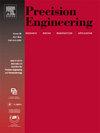电塑性效应对镍基高温合金电辅助切削塑性变形的影响机理
IF 3.7
2区 工程技术
Q2 ENGINEERING, MANUFACTURING
Precision Engineering-Journal of the International Societies for Precision Engineering and Nanotechnology
Pub Date : 2025-03-23
DOI:10.1016/j.precisioneng.2025.03.020
引用次数: 0
摘要
本研究采用分子动力学模拟方法,结合纳米尺度传热的焦耳热效应和纳米尺度的电子风效应,研究了电流密度对镍基高温合金电辅助切削过程中应力和位错的影响。分析了切削过程中不同电流密度下材料变形区位错倍增、位错运动和位错纠缠的变化,确定了电塑性效应对材料塑性变形的影响。结果表明:在电流作用下,与塑性变形相关的平均应力和位错密度显著降低;施加的电流导致工件显著的温升,并减少了材料变形过程中的加工硬化行为。工件内部的应力和电流密度随电流密度的增大而减小。在最大电流密度的情况下,工件的内应力和电流密度变化明显。与普通切削相比,应力最大峰值降低16%,位错密度最大峰值降低30%。随着电流密度的增大,材料最大位错密度的峰值提前。电子风效应促进位错滑移,施加的电流显著提高了工件的塑性。本文章由计算机程序翻译,如有差异,请以英文原文为准。
Influence mechanism of electroplasticity effect on plastic deformation during electrical-assisted cutting nickel-based superalloys
In this study, the effect of current density on stresses and dislocations during electrical-assisted cutting nickel-based superalloys has been investigated by using molecular dynamics simulations combined with the Joule heat effect of heat transfer in nanoscale and the electron wind effect in nanoscale. The changes of dislocation multiplication, dislocation movement and dislocation entanglement in the deformation zone of the material during the cutting process at different current densities were analyzed to determine the effect of electroplastic effect on the plastic deformation of the material. The results show that the average stress and dislocation density related to plastic deformation are significantly reduced under the action of current. The applied current leads to a significant temperature rise of the workpiece and reduces the work hardening behavior during the deformation of the material. The stress and current density inside the workpiece decrease with the increase of current density. In the case of maximum current density, the internal stress and current density of the workpiece change significantly. Compared with ordinary cutting, the maximum peak value of stress is reduced by 16 %, and the maximum peak value of dislocation density is reduced by 30 %. With the increase of current density, the peak of the maximum dislocation density of the material is advanced. The electron wind effect promotes dislocation slip, and the applied current significantly enhances the plasticity of the workpiece.
求助全文
通过发布文献求助,成功后即可免费获取论文全文。
去求助
来源期刊
CiteScore
7.40
自引率
5.60%
发文量
177
审稿时长
46 days
期刊介绍:
Precision Engineering - Journal of the International Societies for Precision Engineering and Nanotechnology is devoted to the multidisciplinary study and practice of high accuracy engineering, metrology, and manufacturing. The journal takes an integrated approach to all subjects related to research, design, manufacture, performance validation, and application of high precision machines, instruments, and components, including fundamental and applied research and development in manufacturing processes, fabrication technology, and advanced measurement science. The scope includes precision-engineered systems and supporting metrology over the full range of length scales, from atom-based nanotechnology and advanced lithographic technology to large-scale systems, including optical and radio telescopes and macrometrology.

 求助内容:
求助内容: 应助结果提醒方式:
应助结果提醒方式:


